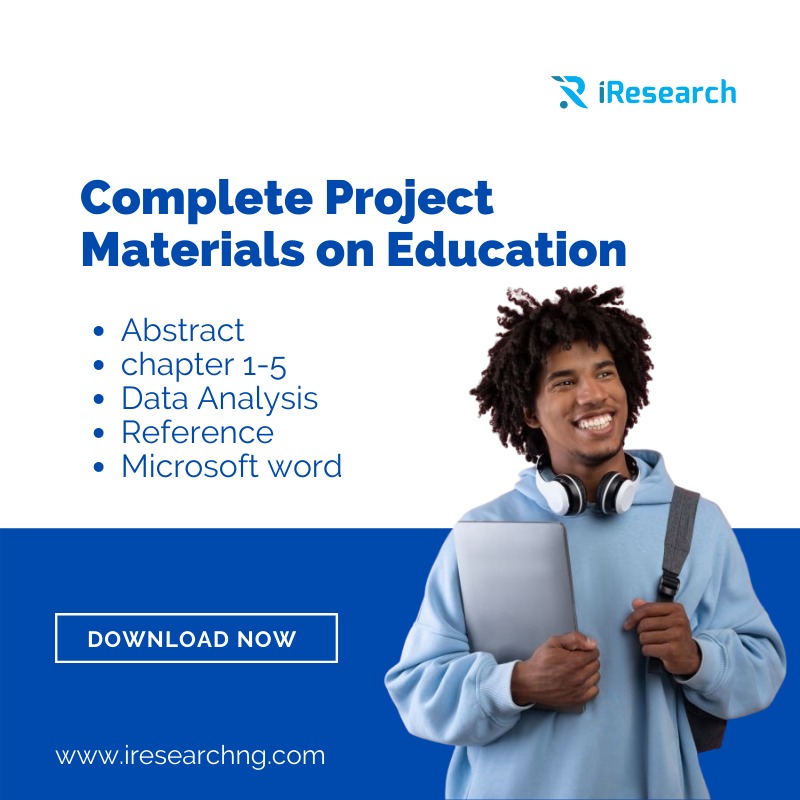



CHAPTER ONE
1.1INTRODUCTION
Communication is the livelihood of today’s business. Electronic data communication is becoming the industry standard of transaction media and widely used in such areas as education, payment of bills, video conferencing, and group work collaboration, etc through tele-education and tele-medicines, as already practiced in many developed countries such as South Africa, India and China, education and health can be brought to the door step of the rural and deprived urban cities in all countries in Africa.
Tertiary education occupies the apex of education endeavours in Nigeria. Tertiary education is offered after secondary education in universities, colleges of education, polytechnic, and monotechnics, among others. The goals of tertiary education as noted in the national policy on education (FRN, 2004) include the contribution to national development through high level manpower training, development and inculcation of proper values for the survival of Nigerian society and individuals development of the individual intellectual capabilities so as to understand their immediate and local environment, and provide opportunities for the acquisition of physical and intellectual skills necessary for individuals to be self-reliant and be useful member of the society. It is also meant to promote and encourage scholarship and community service forge and promote national unity, and the promotion of national and international understanding.
Information and communication technology (ICT) is defined as computer based tools used by people to work with the information and communication processing needs of an organization. It is widely acknowledged that ICTs can be used to improve the quality of teaching and learning in any tertiary institution. the prevalence and rapid development of information and communication technologies (ICTs) has transformed human society from the information technology age to the knowledge age (Galbreath, 2000). Moursund and Bielefeldts (1999) identified three major ways of using ICT for teaching and learning. These are information technology (IT) assisted learning, technology as a tool and computer and information science. Information technology (IT) assisted learning was divided into;
i. Computer-assisted learning, which is the interaction between a student and a computer system designed to help the students learn to drill and practice, tutorial, simulation and virtual realities.
ii. Computer assisted research implies where ICT is used as an aid to doing library and empirical research. This is enhanced through the growth of world wide web which has created virtual library that can only be accessed by the technological literate.
iii. Distance learning, which is the use of telecommunication, designed to facilitate students learning through e-mail, interactive web sites and two-way audio/video teleconferencing.
Information and communication technology (ICT) should be used as a pedagogically powerful tool for the construction and modeling of knowledge. Inspite of ICT recognized potentials; their integration in teaching learning process will be dependent on teaching. Empirical findings have indicated that even teachers who have competence in the use of ICT do not integrated them in their t4eaching. For instance, Moursund and Bielefeld (1999) report on now teachers use of information technology indicated that;
i. The technology skills of teacher education faculty were comparable to the skills of the student they teach and that
ii. Most teacher educators did not model the use of technology in their teaching. Thus, lectures need to be induced not only to be competent in using ICT but also in integrating them in instruction.
1.2STATEMENT OF THE PROBLEM
The improvement in the development of ICT facilities usage has been of a great deal. It is believed that this improvement has not been felt in the area of academic. Most studnet4s around the world knows how to operate this so called ICT facilities but it contribution to learning and teaching process has not been analyzed which is why this study is been set up to investigate the use of ICT in the learning of integrated science among students teachers in College of Education, Ekiadolor-Benin City.
1.3RESEARCH QUESTIONS
1. How do student teachers use ICT to solve problems in their everyday lives?
2. What conditions do constrain or enable utilization of ICT in student teachers learning?
3. How do student teachers collaborate to address ICT based constraints encountered in their everyday learning practice?
1.4OBJECTIVES OF THE STUDY
1. To determine the extent at which students teachers make use of ICT in their learning process.
2. To determine what constraints hinders the use of ICT in the study area.
3. To suggest solutions to the constraints that hinders the use of ICT in the study area.
1.5SIGNIFICANCE OF THE STUDY
This study is embarked upon to determine the use of ICT in the learning of integrated science among student’s teachers in the College of Education, Ekiadolor, Benin City. Knowing the contribution of the use of ICT facilities will encourage the authority on how to make this facility more available to the students and also educate the available to the students and also educate the novice among the students the importance of using ICT.
NOT THE TOPIC YOU ARE LOOKING FOR?
Once payment is made, kindly send us your project topic, email address and payment name to +234 810 144 4147
Once payment is confirmed, Project materials will be sent to your email